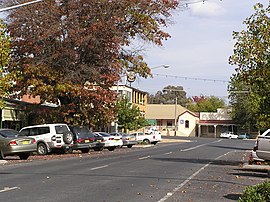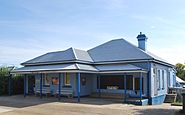| Main | Births etc |
|---|
| Tumbarumba | |
 Main street of Tumbarumba | |
| Population: | 1,487 [1] |
| Established: | 1850s |
| Postcode: | 2653 |
| Coordinates: | Coordinates: |
| Elevation: | 592 m (1,942 ft) |
| Location: |
|
| LGA: | Tumbarumba Shire |
| County: | Selwyn |
| State District: | Albury |
| Federal Division: | Eden-Monaro |
Tumbarumba ( /tʌmbəˈrʌmbə/[2] tum-bə-RUM-bə) is a small town in New South Wales, Australia, about 480 kilometres (300 mi) southwest of the state capital, Sydney. Tumbarumba is located on the periphery of the Riverina and South West Slopes regions at the western edge of the Snowy Mountains. At the 2006 Census of Population and Housing, 1,487 people lived in the town.[1] Tumbarumba Shire is administered from offices located in Tumbarumba.
To the south and east, the highest peak of the Snowy Mountains and mainland Australia—Mount Kosciuszko—can be seen.
History[]
The community was established in the late 1850s after gold was discovered in the district. The Post Office opened on 1 August 1860 but was spelt Tumberumba until 1915.[3]
A railway branch line was opened to Tumbarumba in 1921. The Tumbarumba railway line ran from Wagga Wagga through Tarcutta. The service has been suspended since 1987.
Gold mining petered out in the 1930s, and the region's economy now depends on agriculture and tourism. The timber industry dominates the Shire’s economy.
The name Tumbarumba may be derived from Wiradjuri dhamba dhamba, meaning "very soft" [4] or alternatively from the Aboriginal words for "hollow sounding ground", "thunder", "sound" or "place of big trees".[5]
Industry[]
The major industry in the town is softwood timber processing, with the Hyne and Sons Timber Mill to the east of the town being the biggest employer.[6] Other industries include tourism, viticulture, and blueberry growing. Tourism is a source of income due to its proximity to the snow fields.[7]
Cultural references[]
- In November 1963, New Zealander Johnny Devlin (with Bee Gees on backing vocals) released the single "Stomp The Tumbarumba",[8] a song covered later by, among others, the Australian rock band Hoodoo Gurus (see "Come Anytime" and "1000 Miles Away"). Tumbarumba in the song's title may or may not have something to do with the name of the town.
- Tumbarumba is one of the very few Australian placenames mentioned in James Joyce's prose-poem Finnegans Wake. 'Tumbarumba mountain' is listed as one of the places of origin of HCE (Humphrey Chimpden Earwicker), one of the central characters of the Wake (FW 596.11).
- Shirley Abicair, the UK based Australian singer, made the town of Tumbarumba's name familiar to many British children with the publication of her book "Tales of Tumbarumba" in 1962.
- Tumbarumba is another word for a tmesis, a linguistic term which refers to the placing of a word within another word, such as "ri-goddamn-diculous". The origin of this meaning may come from the poem "Tumba-bloody-rumba" by John O'Grady, which includes several tmeses including "Tumba-bloody-rumba", "e-bloody-nough", and "kanga-bloody-roos".
Climate[]
Tumbarumba has an oceanic climate (Cfb). Frosts are frequent and snowfall is by no means unknown in the winter: the lowest recorded maximum temperature was 1.1 °C (34.0 °F) on 15 July 1966 and the coldest recorded minimum temperature was −10.4 °C (13.3 °F) on 22 June 1989. The hottest recorded maximum is 40.2 °C (104.4 °F) on 7 February 2009.
| Climate data for Tumbarumba Post Office | |||||||||||||
|---|---|---|---|---|---|---|---|---|---|---|---|---|---|
| Month | Jan | Feb | Mar | Apr | May | Jun | Jul | Aug | Sep | Oct | Nov | Dec | Year |
| Record high °C (°F) | 40.0 (104.0) |
40.2 (104.4) |
35.6 (96.1) |
29.4 (84.9) |
23.8 (74.8) |
19.1 (66.4) |
20.0 (68.0) |
22.0 (71.6) |
27.8 (82.0) |
31.5 (88.7) |
36.6 (97.9) |
37.3 (99.1) |
40.2 (104.4) |
| Average high °C (°F) | 28.8 (83.8) |
28.3 (82.9) |
25.0 (77.0) |
19.9 (67.8) |
15.2 (59.4) |
11.7 (53.1) |
10.6 (51.1) |
12.2 (54.0) |
15.2 (59.4) |
19.3 (66.7) |
22.6 (72.7) |
25.9 (78.6) |
19.6 (67.3) |
| Average low °C (°F) | 12.0 (53.6) |
12.0 (53.6) |
8.7 (47.7) |
4.9 (40.8) |
2.3 (36.1) |
0.2 (32.4) |
−0.2 (31.6) |
0.9 (33.6) |
3.0 (37.4) |
5.2 (41.4) |
7.6 (45.7) |
9.5 (49.1) |
5.5 (41.9) |
| Record low °C (°F) | 1.6 (34.9) |
1.9 (35.4) |
−1.3 (29.7) |
−4.1 (24.6) |
−6.7 (19.9) |
−10.4 (13.3) |
−9.4 (15.1) |
−8.1 (17.4) |
−5 (23.0) |
−5.5 (22.1) |
−3.9 (25.0) |
0.1 (32.2) |
−10.4 (13.3) |
| Precipitation mm (inches) | 62.0 (2.441) |
54.9 (2.161) |
66.8 (2.63) |
65.7 (2.587) |
82.0 (3.228) |
102.0 (4.016) |
105.1 (4.138) |
107.2 (4.22) |
91.0 (3.583) |
96.5 (3.799) |
74.9 (2.949) |
70.8 (2.787) |
978.7 (38.531) |
| Avg. precipitation days | 6.0 | 5.6 | 6.3 | 7.2 | 9.4 | 12.1 | 13.1 | 13.2 | 11.4 | 10.3 | 8.2 | 7.3 | 110.1 |
| % humidity | 63 | 70 | 74 | 77 | 87 | 90 | 90 | 83 | 75 | 66 | 67 | 61 | 75 |
| Source: Australian Bureau of Meteorology[9] | |||||||||||||
Sport[]
Tumbarumba Greens fields a rugby league team in the Group 9 competition and the Tumbarumba Kangaroos compete in the Victorian-based Upper Murray Football League.
Gallery[]
See also[]
- Mannus Correctional Centre
References[]
- ^ a b Australian Bureau of Statistics (25 October 2007). "Tumbarumba (Urban Centre/Locality)". 2006 Census QuickStats. http://www.censusdata.abs.gov.au/ABSNavigation/prenav/LocationSearch?collection=Census&period=2006&areacode=UCL176000&producttype=QuickStats&breadcrumb=PL&action=401. Retrieved 2008-03-31.
- ^ Butler, Susan, ed (2009). Macquarie Dictionary (5th ed.). Sydney: Macquarie Dictionary Publishers Pty Ltd. 1952 pages. ISBN 978-1-876-42966-9. http://www.macquariedictionary.com.au.
- ^ Premier Postal History. "Post Office List". https://www.premierpostal.com/cgi-bin/wsProd.sh/Viewpocdwrapper.p?SortBy=NSW&country=. Retrieved 2008-04-11
- ^ McNicol, Sally; Hosking, Dianne (1994). "Wiradjuri". Macquarie Aboriginal Words. Sydney: Macquarie Library. p. 98.
- ^ "Tumbarumba". Geographical Names Register (GNR) of NSW. Geographical Names Board of New South Wales. http://www.gnb.nsw.gov.au/place_naming/placename_search/extract?id=SXjLBKsEan. Retrieved 4 August 2013.
- ^ Jeppe Nielsen (June 2008). "Tumbarumba Integrated Water Cycle Management Strategy". p. 19. http://www.tumbashire.nsw.gov.au/files/2960/File/Attachment_Item10.15DraftIWCMPlan.pdf. Retrieved 2010-01-21.
- ^ "Tumbarumba". Country Change Bureau. http://www.cchange.org.au/resources/1/tumbarumba.pdf. Retrieved 2010-01-21.
- ^ Bee Gees Recordings
- ^ "Climate statistics for Australian locations". Australian Bureau of Meteorology. http://www.bom.gov.au/climate/averages/tables/cw_072043_All.shtml. Retrieved 2013-04-15.
External links[]
Media related to Tumbarumba, New South Wales at Wikimedia Commons
- Tumbarumba Shire Council
- Demographic profile of Tumbarumba Shire in 2001
- Discussion on Lost Poetry web site of authorship of the poem Tumba-bloody-rumba
- Tumbarumba Railway Station
| ||||||||||||||||||||
| This page uses content from the English language Wikipedia. The original content was at Tumbarumba. The list of authors can be seen in the page history. As with this Familypedia wiki, the content of Wikipedia is available under the Creative Commons License. |





